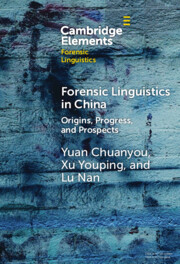Element contents
Forensic Linguistics in China
Published online by Cambridge University Press: 04 April 2024
Summary
- Type
- Element
- Information
- Series: Elements in Forensic LinguisticsOnline ISBN: 9781009162548Publisher: Cambridge University PressPrint publication: 02 May 2024



